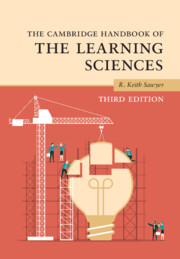Book contents
- The Cambridge Handbook of the Learning Sciences
- The Cambridge Handbook of the Learning Sciences
- Copyright page
- Contents
- Figures
- Tables
- Contributors
- Preface
- 1 An Introduction to the Learning Sciences
- Part I Foundations
- Part II Methodologies
- Part III Grounding Technology in the Learning Sciences
- 14 Video Games and Learning
- 15 Embodiment and Embodied Design
- 16 Tangible and Full-Body Interfaces in Learning
- 17 Augmented Reality in the Learning Sciences
- 18 Mobile Learning
- Part IV Learning Together
- Part V Learning Disciplinary Knowledge
- Part VI Moving Learning Sciences Research into the Classroom
- Index
- References
17 - Augmented Reality in the Learning Sciences
from Part III - Grounding Technology in the Learning Sciences
Published online by Cambridge University Press: 14 March 2022
- The Cambridge Handbook of the Learning Sciences
- The Cambridge Handbook of the Learning Sciences
- Copyright page
- Contents
- Figures
- Tables
- Contributors
- Preface
- 1 An Introduction to the Learning Sciences
- Part I Foundations
- Part II Methodologies
- Part III Grounding Technology in the Learning Sciences
- 14 Video Games and Learning
- 15 Embodiment and Embodied Design
- 16 Tangible and Full-Body Interfaces in Learning
- 17 Augmented Reality in the Learning Sciences
- 18 Mobile Learning
- Part IV Learning Together
- Part V Learning Disciplinary Knowledge
- Part VI Moving Learning Sciences Research into the Classroom
- Index
- References
Summary
Augmented reality (AR) combines digitally generated 3D content with real-world objects that users are looking at. The “virtual” computer-generated 3D content is overlaid on a view of the real world through a specialized display. All augmented reality technologies involve some form of display technology that combines real and virtual content – including headset devices, camera-enabled smartphones and tablets, computer-based webcams, and projectors displaying interactive images on a physical surface. These technologies support real-time tracking of hands, 3D objects, and bodies as they push on or touch virtual objects. This enables a more-natural interaction between the learner and the virtual content. AR technologies support learning by allowing learners to interact with 3D representations; they enable embedded assessments; they support groups of learners engaging with shared virtual objects; and they tap into a child’s natural inclination to play and experiment by moving around and touching and manipulating objects.
Keywords
- Type
- Chapter
- Information
- The Cambridge Handbook of the Learning Sciences , pp. 340 - 361Publisher: Cambridge University PressPrint publication year: 2022
References
- 1
- Cited by



